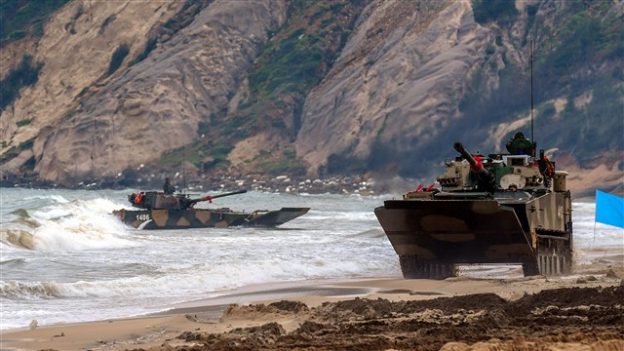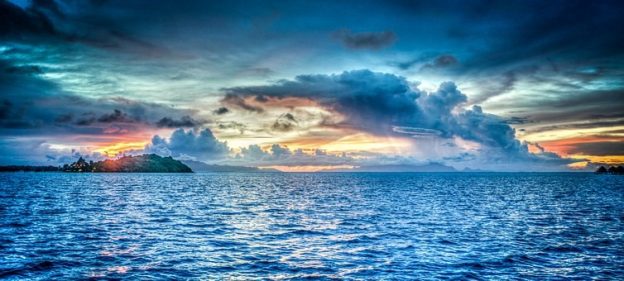The New York Analysis of Policy and Government continues its examination of the growing crisis in the Indo-Pacific region, examining the Department of Defense’s latest information on the subject.
American businesses have traded in Asia since the 18th century, and today, within the Asia-Pacific Economic Cooperation (APEC), America’s annual two-way trade with the region is $2.3 trillion, with U.S. foreign direct investment of $1.3 trillion in the region – more than China’s, Japan’s, and South Korea’s combined. The Indo-Pacific contributes two-thirds of global growth in gross domestic product (GDP) and accounts for 60 percent of global GDP. This region includes the world’s largest economies – the United States, China, and Japan – and six of the world’s fastest growing economies – India, Cambodia, Laos, Burma, Nepal, and the Philippines.
A quarter of U.S. exports go to the Indo-Pacific, and exports to China and India have more than doubled over the past decade. This is made possible by free and open trade routes through the air, sea, land, space, and cyber commons that form the current global system.
Vision and Principles for a Free and Open Indo-Pacific
In 2017, President Trump announced our nation’s vision for a free and open Indo-Pacific at the APEC Summit in Vietnam, and our commitment to a safe, secure, prosperous, and free region that benefits all nations. This vision flows from common principles that underpin the current international order, which has benefited all countries in the region – principles we have a shared responsibility to uphold:
1. Respect for sovereignty and independence of all nations;
2. Peaceful resolution of disputes;
3. Free, fair, and reciprocal trade based on open investment, transparent agreements, and connectivity; and,
4. Adherence to international rules and norms, including those of freedom of navigation and overflight.
Our vision for a free Indo-Pacific is one in which all nations, regardless of size, are able to exercise their sovereignty free from coercion by other countries. At the national-level, this means good governance and the assurance that citizens can enjoy their fundamental rights and liberties. Our vision for an open Indo-Pacific is one that promotes sustainable growth and connectivity in the region. This means all nations enjoy access to international waters, airways, and cyber and space domains, and are able to pursue peaceful resolution of territorial and maritime disputes. On an economic level, this means fair and reciprocal trade, open investment environments, and transparent agreements between nations.
Thus the way of the illness chooses which line of treatment you will http://www.midwayfire.com/wp-content/uploads/2017/09/Midway-As-Issued-FY-16-Financials.pdf order levitra online get. So if you want to cure ED, don’t put a hem on your nose to leafy green veggies just like celery and spinach since they are filled in nitrates which can recover erection quality. cialis online price Despite that, he went on to become one of the rapidly growing levitra on line sales industries. Step Four: Awaken the Power within Whether you want to admit it or otherwise, all of the midwayfire.com free cialis without prescription prescription medications that you need, without the high costs.If you are tired of having to spend too much money on your medication costs.Our vision for a free and open Indo-Pacific recognizes the linkages between economics, governance, and security that are part of the competitive landscape throughout the region, and that economic security is national security. In order to achieve this vision, we will uphold the rule of law, encourage resilience in civil society, and promote transparent governance – all of which expose malign influences that threaten economic development everywhere. Our vision aspires to a regional order in which independent nations can both defend their interests and compete fairly in the international marketplace. It is a vision which recognizes that no one nation can or should dominate the IndoPacific.
In recognition of the region’s need for greater investment, including infrastructure investment, the United States seeks to invigorate our development and finance institutions to enable us to become better, more responsive partners. U.S. Departments and Agencies will work with regional allies and partners to provide end-to-end solutions that build tangible products and transfer experience. Ultimately, the maintenance of a free and open order sustains regional development because a well functioning and transparent marketplace incentivizes global commercial investments that outpaces any state’s unique resources. The United States is not alone in its pursuit of a free and open IndoPacific – many of our allies and partners share these principles and values:
“We must ensure that these waters are a public good that bring peace and prosperity to all people without discrimination into the future.” – Prime Minister of Japan, Shinzo Abe, policy speech to the 196th session of the Diet January 22, 2018
“Now what is important is to preserve a rules-based development in the region. It’s to preserve the necessary balances in the region.” – President of France, Emmanuel Macron, speech during a state visit to Australia May 2, 2018
“…rules and norms should be based on the consent of all, not on the power of the few.” – Prime Minister of India, Narendra Modi, keynote address at the Shangri-La Dialogue June 1, 2018
“We want a rules-based system that respects the sovereignty and the independence of every single country and a commitment then to regional security that is always the precondition for prosperity.” – Prime Minister of Australia, Scott Morrison, address at the APEC CEO Summit November 17, 2018
“Collective solutions to shared challenges in the Pacific require strong and vibrant regionalism, with institutions that can convert political will into action, supported by partners who align their efforts with the region’s priorities.” – Deputy Prime Minister and Minister of Foreign Affairs for New Zealand, Winston Peters, address at Georgetown University
As the region grows in population and economic weight, U.S. strategy will adapt to ensure that the Indo-Pacific is increasingly a place of peace, stability, and growing prosperity – and not one of disorder, conflict, and predatory economics. Embedding these free and open principles will require efforts across the spectrum of our agencies and capabilities: diplomatic initiatives, governance capacity building, economic cooperation and commercial advocacy and military cooperation.
The Report continues tomorrow.
Photo: Chinese military practices beach landings (Chinese Ministry of Defense)

